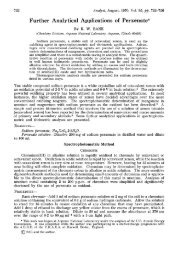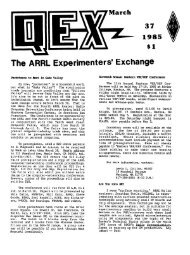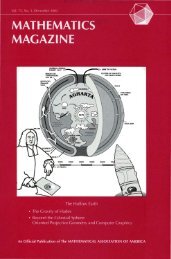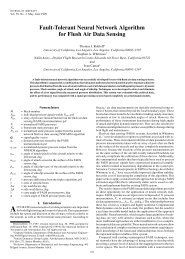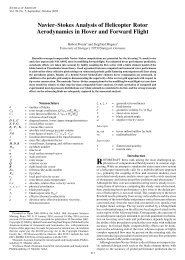Quantitative Analysis of Alkaloids From Cinchona Bark by Hig h ...
Quantitative Analysis of Alkaloids From Cinchona Bark by Hig h ...
Quantitative Analysis of Alkaloids From Cinchona Bark by Hig h ...
Create successful ePaper yourself
Turn your PDF publications into a flip-book with our unique Google optimized e-Paper software.
ANALYST. OCTOBER 1990, VOL. 115 1355<br />
<strong>Quantitative</strong> <strong>Analysis</strong> <strong>of</strong> <strong>Alkaloids</strong> <strong>From</strong> <strong>Cinchona</strong> <strong>Bark</strong> <strong>by</strong><br />
<strong>Hig</strong> h-performance Liquid Chromatography<br />
David V. McCalley<br />
Department <strong>of</strong> Science, Bristol Polytechnic, Frenchay, Bristol BS16 1QK UK<br />
A procedure has been developed for the extraction and quantitative analysis <strong>of</strong> the major alkaloids from<br />
<strong>Cinchona</strong> bark using high-performance liquid chromatography. The method uses a commercial octylsilyl-<br />
bonded column, recommended for basic compounds, in the reversed-phase mode. The method is<br />
reproducible (relative standard deviation approximately 4% for each alkaloid) and gives quantitative recovery<br />
<strong>of</strong> alkaloids added to bark samples (100-103%). A variety <strong>of</strong> different types <strong>of</strong> bark have been studied<br />
successfully in the validation scheme. The method can be extended to the analysis <strong>of</strong> some minor alkaloids<br />
which are <strong>of</strong> interest in the elucidation <strong>of</strong> the biosynthetic pathways <strong>of</strong> alkaloid production.<br />
Keywords : <strong>Cinchona</strong> alkaloid; high -perf0 rmance liquid chroma tog rap h y; basic compound<br />
The principal <strong>Cinchona</strong> alkaloids quinine (Qn), quinidine<br />
(Qd), cinchonine (Cn) and cinchonidine (Cd) are important<br />
compounds used in the pharmaceutical, food and drink<br />
industries. The spread <strong>of</strong> resistance to the synthetic drug<br />
chloroquine in the parasite Plasmodium falciparum has<br />
re-established quinine as an antimalarial drug; there is also<br />
interest in the antimalarial activity <strong>of</strong> other <strong>Cinchona</strong> alka-<br />
loids. Quinidine, a diastereoisomer <strong>of</strong> quinine, is widely used<br />
as an antiarrhythmic drug. Quinine is a major source <strong>of</strong> bitter<br />
flavouring in the food industry. <strong>Cinchona</strong> bark continues to be<br />
the source <strong>of</strong> these compounds, in the absence <strong>of</strong> a commer-<br />
cially viable synthetic route <strong>of</strong> production.1 The structural<br />
formulae <strong>of</strong> some <strong>of</strong> the alkaloids found in <strong>Cinchona</strong> bark are<br />
given below.<br />
Ho H2& *u<br />
Ro5' Ra<br />
N'<br />
Qn, R = OCH3<br />
Cd, R = H<br />
CH2=CH<br />
\/H<br />
OH<br />
Hzc=2<br />
H<br />
HO<br />
Qd, R = OCH3<br />
Cn, R = H<br />
Quinamine <strong>Cinchona</strong>mine<br />
Corynantheal<br />
The quantitative analysis <strong>of</strong> <strong>Cinchona</strong> bark has been<br />
performed for many years in order to ascertain its commercial<br />
value <strong>by</strong> the classical methods <strong>of</strong> titrimetry, gravimetry and<br />
polarimetry. More recently, the analysis <strong>of</strong> the <strong>Cinchona</strong><br />
alkaloids has been reported using high-performance liquid<br />
chromatography (HPLC) . <strong>Hig</strong>h-performance LC procedures<br />
have been published using both normal phase systems with a<br />
silica column, and with reversed-phase systems primarily on<br />
octyl- or octadecylsilyl columns. Although normal phase<br />
systems can give excellent results,2 reversed-phase systems are<br />
generally considered more convenient and the cost <strong>of</strong> the<br />
eluents is lower when large numbers <strong>of</strong> determinations are<br />
carried out .3 However, reversed-phase chromatography is<br />
complicated <strong>by</strong> the high basicity <strong>of</strong> the alkaloids (pK, value <strong>of</strong><br />
quinine = 9.74). This property can lead to severe peak tailing<br />
or even complete retention <strong>of</strong> the alkaloids, due to interaction<br />
with underivatised silanol groups that persist on the surface <strong>of</strong><br />
these columns.5 It is likely that ion-exchange interactions<br />
occur between protonated alkaloid and isolated highly acidic<br />
silanols, which are dissociated even at relatively low pH.6<br />
In this paper further observations on the HPLC analysis <strong>of</strong><br />
the <strong>Cinchona</strong> alkaloids using a column recommended for the<br />
analysis <strong>of</strong> basic compounds are reported. Detailed quantitative<br />
aspects <strong>of</strong> extraction and recovery <strong>of</strong> alkaloids from bark<br />
using HPLC analysis are also described; no papers appear to<br />
have dealt with this subject previously.<br />
Experimental<br />
The HPLC system, incorporating an Altex 100 pump, a Philips<br />
LC3 UV detector and a Rheodyne 7125 valve, was as used<br />
previously.7Column efficiency (N) and asymmetry factor (As)<br />
were calculated at half and 10% <strong>of</strong> peak height using a<br />
microcomputer data station. The principal column used was<br />
LiChrosorb RP-8 Select B, 5 pm, 25 x 0.4 cm i.d. (Merck,<br />
Darmstadt, FRG). Ten microlitre injections <strong>of</strong> sample were<br />
invariably used.<br />
The phosphate eluent was prepared <strong>by</strong> dissolving 6.805 g <strong>of</strong><br />
pure potassium dihydrogen orthophosphate in 425 cm3 <strong>of</strong><br />
distilled water, adjusting to pH 3.0 with concentrated phos-<br />
phoric acid and mixing with 75 cm3 <strong>of</strong> acetonitrile (HPLC<br />
grade, Fisons, Loughborough, Leicestershire, UK). This<br />
method <strong>of</strong> preparation resulted in a phosphate concentration<br />
slightly above 0.1 M although this was <strong>of</strong> no significance. The<br />
hexylamine phosphate buffer was prepared <strong>by</strong> pipetting 3.30<br />
cm3 <strong>of</strong> hexylamine into 460 cm3 <strong>of</strong> distilled water, adjusting to<br />
pH 3.0 with concentrated phosphoric acid and mixing with 40<br />
cm3 <strong>of</strong> acetonitrile. When the solutions are prepared in this<br />
way, problems <strong>of</strong> buffer precipitation in the instrument are, to<br />
a great extent, avoided. To remove hexylamine from the<br />
column washing with distilled water followed <strong>by</strong> pure<br />
methanol until a stable baseline is obtained is recommended.<br />
Quinine, quinidine and dihydroquinidine (Had) were<br />
obtained from Fluka (Buchs, Switzerland), cinchonine and
1356 ANALYST, OCTOBER 1990, VOL. 115<br />
cinchonidine from Sigma (Poole, Dorset, UK), dihydroqui-<br />
nine (HQn), dihydrocinchonine (HCn) and dihydrocinchoni-<br />
dine (HCd) from ACF Chemiefarma (Maarssen, The Nether-<br />
lands). The Cn and Cd standards were found, <strong>by</strong> HPLC<br />
analysis, to contain significant amounts <strong>of</strong> the corresponding<br />
dihydro compounds (16 and 6% , respectively). These figures<br />
were taken into account in all quantitative work. The Qn and<br />
Qd standards contained 25; see also reference 11). A simple<br />
step-gradient analysis is recommended, increasing the aceto-<br />
nitrile content after the elution <strong>of</strong> HQn if the analysis <strong>of</strong><br />
CnAm is to be performed routinely. For instance, the<br />
retention time <strong>of</strong> CnAm is only about 30 min with the simple<br />
phosphate buffer containing 20% acetonitrile. Isocratic<br />
systems in which the organic modifier concentration is high in<br />
order to reduce the retention time <strong>of</strong> CnAm (for instance <strong>by</strong><br />
addition <strong>of</strong> the strong solvent THF) show a significant loss <strong>of</strong><br />
resolution <strong>of</strong> the earlier eluting peaks.9 The corynantheal<br />
peak is very broad in either buffer, with a column efficiency <strong>of</strong><br />
ANALYST, OCTOBER 1990, VOL. 115 1357<br />
t<br />
v)<br />
0 P<br />
I I J<br />
0 5<br />
Ti me/m in<br />
Fig. 2. Chromatogram <strong>of</strong> 9. nicotine and 6, Qn on pH stable alumina<br />
ODS column (10 cm, 3 pm). Eluent, acetonitrile - ammonia (55 + 45),<br />
pH 11.4<br />
other than silanol group interaction. Recently, pH stable<br />
octadecylsilyl columns have become available which can be<br />
used with eluents at very high pH values at which the alkaloids<br />
are not protonated. Fig. 2 shows a chromatogram <strong>of</strong> quinine<br />
together with nicotine, another basic compound, on an<br />
alumina-ODS type column. Quinine still gives poor results;<br />
nicotine gives a much better peak shape, even though it is<br />
more basic (pK, = 11.04) than quinine. However, the stereo-<br />
chemistry <strong>of</strong> the basic group is likely to be important. It is<br />
possible that the <strong>Cinchona</strong> alkaloids might undergo detrimen-<br />
tal interaction with metal ions in the column.12 The study <strong>of</strong><br />
such effects is hampered <strong>by</strong> the confidential nature <strong>of</strong> the<br />
commercial column specification and the necessity to destroy<br />
the column in order to analyse the packing.<br />
Detection and Calibration <strong>of</strong> the System<br />
A detection wavelength <strong>of</strong> 220 nm was generally used for the<br />
determination <strong>of</strong> the <strong>Cinchona</strong> alkaloids as this is in the region<br />
<strong>of</strong> their maximum ultraviolet absorbance. <strong>Cinchona</strong>mine and<br />
corynantheal also give strong absorbance in this region;<br />
although the maximum absorbance for QAm occurs nearer to<br />
200 nm, it still has adequate absorbance at 220 nm. An<br />
indication <strong>of</strong> the purity <strong>of</strong> the peaks can be gained <strong>by</strong><br />
monitoring the absorbance ratio at 220 nm and some other<br />
suitable wavelength (e.g., 312 nm). The detector response<br />
versus concentration <strong>of</strong> solution injected was assessed over the<br />
range 0-100 mg 1-1 for each <strong>of</strong> the principal Qn alkaloids using<br />
the hexylamine buffer system. Using peak height as a measure<br />
<strong>of</strong> detector response, the calibration graphs were linear over<br />
this range with correlation coefficients for Cn, Cd, Qd and Qn<br />
<strong>of</strong> 0.9999, 0.9999, 0.9998 and 0.9998, respectively. For<br />
peak-area measurements the correlation coefficients were<br />
0.9999, 0.9997, 0.9999 and 0.9998, respectively. Calibration<br />
graphs for the simple phosphate buffer yielded similar values.<br />
In general, it was considered preferable to use peak-height<br />
measurements (from the data system) rather than peak area as<br />
they are less susceptible to potential interference from<br />
co-extracted material. Interference is rarely a problem with<br />
<strong>Cinchona</strong> bark extracts due to the relatively high alkaloid<br />
content (confirmed <strong>by</strong> studies using a photodiode array<br />
detector13) but this factor may be <strong>of</strong> significance when<br />
analysing the low levels <strong>of</strong> alkaloids typically found in cell<br />
culture samples.<br />
Extraction <strong>of</strong> <strong>Alkaloids</strong> <strong>From</strong> <strong>Cinchona</strong> <strong>Bark</strong><br />
The Bruxelles standard method for pre-treatment and extrac-<br />
tion <strong>of</strong> <strong>Cinchona</strong> bark14 involves grinding and sieving, drying<br />
at 110 "C (at which temperature no loss <strong>of</strong> alkaloids was<br />
reported), treatment with alkali and finally Soxhlet extraction<br />
with benzene. However, this method was established for the<br />
subsequent determination <strong>of</strong> only two alkaloids (Cd and Qn)<br />
Table 1. Evaluation <strong>of</strong> different solvents for Soxhlet extraction <strong>of</strong><br />
<strong>Cinchona</strong> bark. (<strong>Cinchona</strong> ledgerianu). All results given as per cent.<br />
<strong>of</strong> bark, dry mass<br />
Cincho- Cincho-<br />
Solvent nine nidine Quinidine Quinine<br />
Toluene . . . . . .
1358<br />
c<br />
- I<br />
40<br />
30<br />
20<br />
E“ lo<br />
a<br />
v- 2 0<br />
2 40<br />
-<br />
(D<br />
Y<br />
a<br />
30<br />
20<br />
10<br />
(a)<br />
Cd<br />
0 5 10 15 20<br />
Alkaloid added/mg I-’<br />
Fig. 4. Rccovcries <strong>of</strong> alkaloids spiked into <strong>Cinchona</strong> calisaya bark.<br />
Peak identities and eluent as for Fig. l(b). Recovery <strong>of</strong> (a) Cn and Cd;<br />
and (h) Qn and Qd<br />
2<br />
34 5<br />
h<br />
0 5 10 15<br />
Time/mi n<br />
Fig. 5. Chromatogram <strong>of</strong> unspiked <strong>Cinchona</strong> calisaya bark after<br />
extraction with toluene - alkali. Peak identities and eluent as for Fig.<br />
l(b)<br />
extraction can provide a more rapid alternative to the Soxhlet<br />
method. 13<br />
Recovery Studies <strong>of</strong> <strong>Alkaloids</strong> <strong>From</strong> <strong>Bark</strong><br />
In order to validate further the methods used, 100-mg samples<br />
<strong>of</strong> a <strong>Cinchona</strong> bark (<strong>Cinchona</strong> calisaya) were spiked with<br />
amounts <strong>of</strong> Cn, Cd, Qd and Qn <strong>by</strong> the addition <strong>of</strong> a<br />
concentrated solution <strong>of</strong> the alkaloids. The solution was<br />
prepared <strong>by</strong> weighing out equal amounts <strong>of</strong> each solid and<br />
dissolving them in methanol. The presence <strong>of</strong> varying amounts<br />
<strong>of</strong> dihydro impurities in the standard compounds, resulted in a<br />
slightly different range <strong>of</strong> additions <strong>of</strong> pure standard com-<br />
pound. The samples were then extracted using the usual<br />
method. The endogenous levels <strong>of</strong> Cn, Cd, Qd and Qn in the<br />
original dry sample were 0.25, 1.23, 0.34 and 1.20%,<br />
respectively, with solution concentrations for HPLC analysis<br />
<strong>of</strong> 2.5,12.3,3.4 and 12.0 mg I-’. Fig. 4 shows that the recovery<br />
<strong>of</strong> alkaloids over the range added (equivalent to 5-20 mg 1-1<br />
for Qn and Qd; 4.2-16.8 mg 1-1 for Cn; and 4.7-18.8 mg 1-1<br />
for Cd) was linear. The mean recoveries for Cn, Cd, Qd and<br />
Qn obtained from the slopes <strong>of</strong> the lines were 101, 101, 103<br />
6<br />
ANALYST, OCTOBER 1990. VOL. 115<br />
Table 2. Determination <strong>of</strong> the precision <strong>of</strong> bark extraction with<br />
toluene after alkali addition followed <strong>by</strong> HPLC. All results were<br />
calculated from extraction and analysis <strong>of</strong> five samples <strong>of</strong> homo-<br />
genised <strong>Cinchona</strong> succirubra bark<br />
Cincho- Cincho-<br />
Parameter<br />
Mean (% <strong>of</strong> bark dry<br />
nine nidine Quinidine Quinine<br />
mass) . . . . . . 0.52 2.50 C0.03 3.73<br />
Standard deviation, % . . 0.025 0.11 - 0.15<br />
RSD,% . . . . . . 4.8 4.3 -<br />
and loo%, respectively, which indicates excellent performance.<br />
However, such additions can never simulate the exact<br />
occurrence <strong>of</strong> the alkaloids in bark and thus the results should<br />
be treated with some caution. Fig. 5 shows a chromatogram <strong>of</strong><br />
the unspiked bark. Comparison with Fig. 3 shows clearly the<br />
natural variations in alkaloid content which can occur in<br />
different samples.<br />
Assessment <strong>of</strong> Precision <strong>of</strong> the <strong>Analysis</strong><br />
In order to assess the precision <strong>of</strong> the analysis, a <strong>Cinchona</strong><br />
succirubra sample was analysed repeatedly using extraction<br />
with toluene after alkali addition. The results are presented in<br />
Table 2. The precision <strong>of</strong> the entire analytical process for Cn,<br />
Cd and Qn in terms <strong>of</strong> the relative standard deviation (RSD) is<br />
about 4%. Unfortunately, it was not possible to calculate the<br />
relevant values for Qd due to the low endogenous levels <strong>of</strong> the<br />
compound in the sample. The precision <strong>of</strong> the analysis could<br />
probably be improved <strong>by</strong> the addition <strong>of</strong> an internal standard<br />
to the bark prior to extraction. Dihydroquinine has been<br />
recommended9 but is clearly a significant constituent <strong>of</strong> the<br />
samples that were analysed in the present study. The selection<br />
<strong>of</strong> an internal standard is complicated <strong>by</strong> the large number <strong>of</strong><br />
similar compounds present in <strong>Cinchona</strong> bark and the difficulty<br />
<strong>of</strong> simulating the occurrence <strong>of</strong> the compounds in the plant<br />
matrix.<br />
The authors thank R. Verpoorte, University <strong>of</strong> Leiden, The<br />
Netherlands for the kind gifts <strong>of</strong> corynantheal, cinchonamine<br />
and quinamine, and ACF Chemiefarma, Maarssen, The<br />
Netherlands for gifts <strong>of</strong> the dihydroalkaloid standards. D.<br />
Millen, AFP Consultants, Reading, UK, is thanked for<br />
helpful discussions. The samples <strong>of</strong> bark were kindly provided<br />
<strong>by</strong> R. W. Walker, Fife, UK.<br />
1.<br />
2.<br />
3.<br />
4.<br />
5.<br />
6.<br />
7.<br />
8.<br />
9.<br />
10.<br />
11.<br />
12.<br />
13.<br />
14.<br />
15.<br />
References<br />
Verpoorte, R., Schripsema, J., and van der Leer, T., in Brossi,<br />
A., Editor, “The <strong>Alkaloids</strong>,” Academic Press, San Diego,<br />
1988, Volume 34, Chapter 6, p. 331.<br />
McCalley, D. V., J. Chromatogr., 1983, 260, 184.<br />
Wijnsma, R., and Verpoorte, R., Cell Culture Somatic Cell<br />
Genetics Plants, 1988, 5, 335.<br />
Budavari, S., Editor, “The Merck Index,” Eleventh Edition,<br />
Merck, Rahway, NJ, 1989.<br />
McCalley, D. V., Chromatographia, 1983, 17, 264.<br />
Cox, G. B., and Stout, R. W., J. Chromatogr., 1987,384,315.<br />
McCalley, D. V., J. Chromatogr., 1986, 357, 221.<br />
Engelhardt, H., and Jungheim, M., Chromatographia, 1990,<br />
29, 59.<br />
Hermans-Lokkerbol, A., van der Leer, T., and Verpoorte, R.,<br />
J. Chromatogr., 1989, 479, 39.<br />
Meyer, V. R., J. Chromatogr., 1985, 334, 197.<br />
Hamill, J. D., Robins, R. J., and Rhodes, M. J., Planra Med.,<br />
1989, 55. 354.<br />
Ohtsu, Y., Shiojima, Y., Okumura, T., Koyama. J., Naka-<br />
mura, K., Nakata, O., Kimata, K., and Tanaka, N., J.<br />
Chromatogr., 1989,481, 147.<br />
Wadley, I., and McCalley, D. V., unpublished work.<br />
Lebrun, I., Warlet, M., and Schicharevitch, G., Ind. Chim.<br />
Belge, 1950, 15, 328.<br />
Haznagy, A., Pharmazie, 1976,31, 713.<br />
Paper 010091 8 K<br />
Received February 28th, 1990<br />
Accepted June 7th, 1990<br />
4.1



